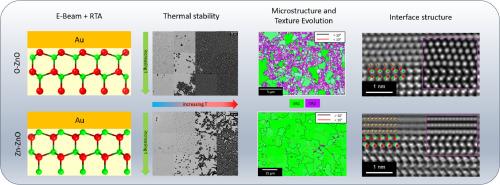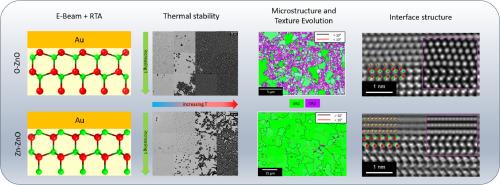Influence of substrate polarity on thermal stability, grain growth and atomic interface structure of Au thin films on ZnO surfaces
IF 8.3
1区 材料科学
Q1 MATERIALS SCIENCE, MULTIDISCIPLINARY
引用次数: 0
Abstract
The influence of the polarity of ceramic substrates on the structural evolution of thin metal films during annealing at elevated temperatures is investigated, including the competing processes of solid state dewetting (SSD) and grain growth, as well as the atomic structure of the epitaxial interface. For this purpose, Au thin films on polar O-ZnO and Zn-ZnO surfaces are annealed at elevated temperatures and times. Whereas SSD dominates on the O-terminated surface, pronounced grain growth is observed on the Zn-terminated surface. The texture analysis revealed that up to 600 °C, both samples exhibit a fiber texture with slightly dominating Au(111)[110] || ZnO(0001)[] orientation relation (OR 2). At 800 °C, Au on Zn-ZnO exhibits a transformation to a mazed bicrystal structure with Au(111)[110] || ZnO(0001)[] orientation relation (OR 1). Comparison of various interface structures in density-functional theory (DFT) indicates that atomically sharp interfaces between the Au(111) films and the ideal bulk-truncated polar ZnO surfaces are energetically favored for both substrate polarities in excellent agreement with atomically resolved electron microscopy. Due to the larger period of the coincidence site lattice in OR 2, the corresponding interface can be described as semi-coherent with clearly separated misfit dislocations. In contrast, the much smaller period of the (approximate) coincidence site lattice in OR 1 leads to a largely incoherent interface with local reconstructions. However, in the experimental situation, even a small rotational deviation from the perfect OR 1 can introduce an interfacial screw dislocation network superimposed on the incoherent interface structure, effectively making the interface semi-coherent.


基底极性对氧化锌表面金薄膜的热稳定性、晶粒生长和原子界面结构的影响
本文研究了陶瓷基底的极性对金属薄膜在高温退火过程中结构演变的影响,包括固态脱湿(SSD)和晶粒生长的竞争过程以及外延界面的原子结构。为此,对极性 O-ZnO(0001¯)(0001¯) 和 Zn-ZnO(0001)(0001)表面上的金薄膜进行了高温和长时间退火。在 O 端表面上,SSD 占主导地位,而在 Zn 端表面上则观察到明显的晶粒生长。纹理分析表明,在 600°C 以下,两种样品都呈现出纤维纹理,Au(111)[110] || ZnO(0001)[112¯0112¯0]取向关系略占优势(OR 2)。在 800°C 时,Zn-ZnO 上的金转变为具有 Au(111)[110] || ZnO(0001)[101¯0101¯0]取向关系的迷宫式双晶结构(OR 1)。密度泛函理论(DFT)中各种界面结构的比较表明,在两种基底极性下,Au(111)薄膜与理想的体截极性 ZnO 表面之间的原子尖锐界面在能量上都是有利的,这与原子分辨电子显微镜非常一致。由于 OR 2 中重合位点晶格的周期较大,相应的界面可描述为半相干,错位明显分离。与此相反,OR 1 中(近似)重合位点晶格的周期要小得多,导致界面在很大程度上不连贯,存在局部重构。然而,在实验中,即使与完美的 OR 1 有很小的旋转偏差,也会在不连贯的界面结构上叠加一个界面螺旋位错网络,从而有效地使界面半连贯。
本文章由计算机程序翻译,如有差异,请以英文原文为准。
求助全文
约1分钟内获得全文
求助全文
来源期刊

Acta Materialia
工程技术-材料科学:综合
CiteScore
16.10
自引率
8.50%
发文量
801
审稿时长
53 days
期刊介绍:
Acta Materialia serves as a platform for publishing full-length, original papers and commissioned overviews that contribute to a profound understanding of the correlation between the processing, structure, and properties of inorganic materials. The journal seeks papers with high impact potential or those that significantly propel the field forward. The scope includes the atomic and molecular arrangements, chemical and electronic structures, and microstructure of materials, focusing on their mechanical or functional behavior across all length scales, including nanostructures.
 求助内容:
求助内容: 应助结果提醒方式:
应助结果提醒方式:


